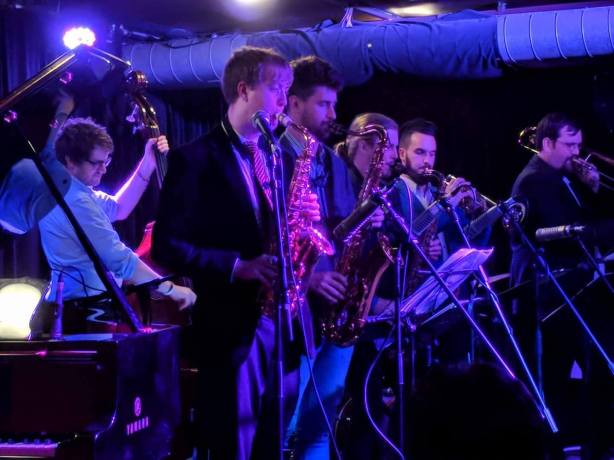Hurrying through an unpredicted rainstorm I was late for the first masterclass of the day. Well this was jazz, the music of the unpredictable, so it sort of fitted.
The masterclass with New Yorkers Kris Davis and Tony Malaby began the one-day Sydney Con International Jazz Festival for 2018. There was talk of intervals in birdsong, and piano clusters, and saxophonist Malaby spoke of actively moving away from jazz forms. The two played a tantalising duet with Davis’ piano shimmering out Messaien-like clusters and chirps. The lovely wood-walled Recital Hall felt, in this hushed and rarified atmosphere, like church.
Barney McAll mentioned the phrase “Music is church” during his masterclass, quoting his long-time employer, Gary Bartz. McAll was next up and his session was as freewheeling and live-wire as Davis/Malaby’s had been pensive and considered. McAll is a unique Wayne Shorter-like figure in Australian jazz, original to the point of almost being his own genre, and intuitively Zen in his approach. He spoke of freedom, Skrillex and technology (giving an insight into the surprisingly mechanistic origins of his compositions). When he sat at the piano to demonstrate, his dynamic attack made me jump (as it always does).
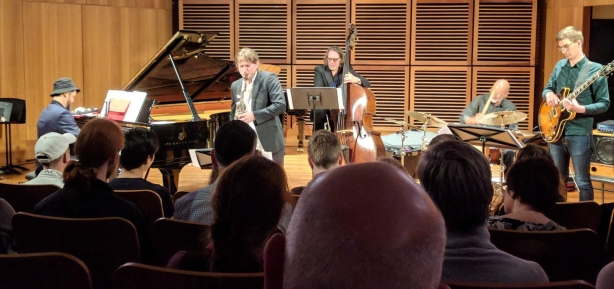
Later in the day I would enjoy McAll in his ASIO (Australian Symbiotic Improvisers Orbit) setting. His band of drummer Hamish Stuart and bass mainstay Jon Zwartz, with “the children” (McAll’s affectionate term) – young guitarist Carl Morgan and Mike Rivett on tenor – took to all the quirky twists and turns in his compositions, which ranged from roiling gnashes of ensemble interplay to intensely beautiful skeins of arpeggio. Was McAll my highlight? In a day of highlights it was hard to say.
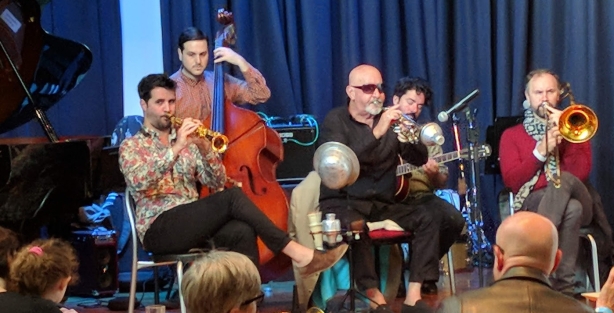
Out of the cloisters and into the much more easy going Jazz Cafe where there was food and drink and people talking – and the rumbunctious Geoff Bull and his young band The Finer Cuts blasting traditional jazz. This music is always a delight – a ribald reminder of the street (and brothel) origins of what has evolved into high art. The triple horn weavings of Bull’s trumpet with tenor and trombone shouted out that joyous anarchy that is still at the heart of even the most contemporary jazz. Pianist Harry Sutherland had the style down in spades, with a rolling grin to his playing. ‘God bless Geoff Bull’ is all I can say.
The Jazz Cafe also presented Darren Heinrich‘s Trio – the classic organ-guitar-drums sound that is one of jazz’s most sublime mutations. The Trio’s sound immediately transformed the Cafe’s club-like atmosphere, the air heavy with imagined nicotine. Guitarist Sam Rollings‘ biting blues-jazz tone was the perfect foil for Heinrich’s intense Hammond attack – at the top of their dynamic the Trio was verging on rock-band loud.
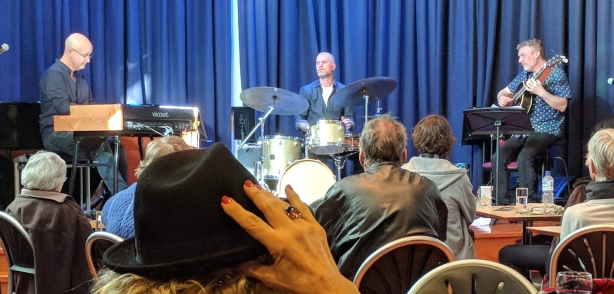
For 2018, the Con Festival’s artistic director, David Theak, brought together a truly fascinating program – impressive not only for its quality, but for the breadth of its range. At the other end of the music’s timeline from the original street music represented here by Geoff Bull, we had the Berlin-based duo Spill. This was truly startling stuff. Both Magda Mayas on (extremely) prepared piano and Tony Buck on drums treated their instruments as boxes of possibilities, to be unpacked in real time, as they played. It was all the more remarkable, considering that both instruments are acoustic percussion instruments, traditionally incapable of a non-tremolo sustain. Well, I heard a piano sing like a bird and a bass drum moan like a wounded bull. The inventiveness of Mayas and Buck was jaw-dropping, but also transportingly beautiful.
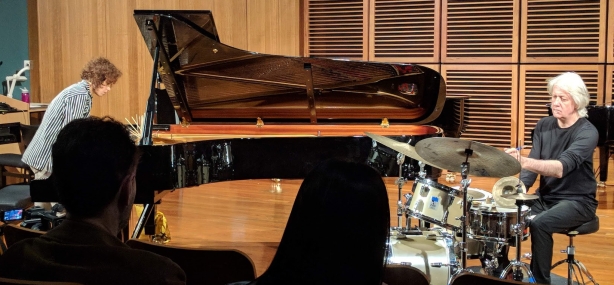
Back to the Jazz Cafe to bring myself back down to earth from the ionosphere. Andrew Scott‘s Pocket Trio were playing, and it was just what I needed. Scott has based his group on the driving but inventive trios of Oscar Peterson and Bill Charlap et al. They swing like hell but can turn on a dime. The other Pocketeers, bassist Max Alduca and drummer Tim Geldens seemed to relish the ride as much as Scott – whose driving and unfrilly playing reminded me more of Tommy Flanagan or even Ray Bryant than the sometimes frilly Peterson. (Scott’s droll spoken song intros are worth admission in themselves).
Fortrified with a few glasses of good red I took in the experience of Stu Hunter‘s ‘Migration’ project. A massive work, performed by a percussion heavy ensemble, it really is something to see (and hear). Grooves are set up and move in and out of rhythmic lattices to reform into new grooves. The players he assembled worked the material beautifully in their solos, notably saxophonist/clarinetist Julien Wilson and Phil Slater on trumpet, with Tina Harrod‘s voice lending an ethereal Gospel edge to the atmosphere set up by Hunter’s astounding ensemble writing.
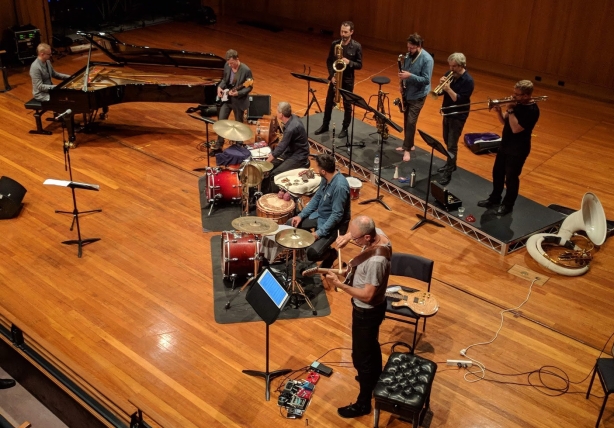
David Theak had joked with me that if I stayed “dawn till dusk” he would shout me a cold one. By the time it came around for the last concert of the day – the international Festival star artist Gretchen Parlato – I was still fresh as a daisy, buoyed by the energy of all the superlative music I had witnessed. And her music made me feel as it I was floating on air.
As all truly great jazz vocalists before here, Parlato’s voice was an instrument among instruments. The unique makeup of her ensemble – gut-string guitar, cello and percussion – surrounded her airy voice with an ebb-and-flow of an entirely organic nature as she moved thru bossa and Bach, and beyond. The effect was mesmerising. The Verbruggen Hall seemed at times too large for the intimacy Parlato and her group conjured – I would have loved to hear her in a closer, smaller space. But this is a small quibble, too small for so sublime an experience.
So to the train home, high as a kite from such a day. Weaving through the swelling VIVID crowds coming into the sparkling city as I was going out, I knew it would take me a while to process it all.
Finally, thanks to David and the Con for putting their resources behind such a landmark event. Jazz is a living, breathing music and it is gratifying to see audiences for such a program not only exist, but exist in enthusiastic numbers.
